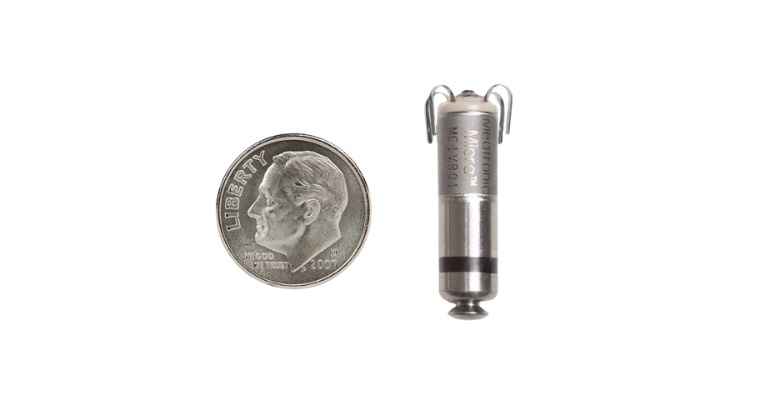Medtronic's Micra, approved by FDA in April 2016, was the first leadless pacemaker to reach the U.S. market. The device is an example of how medical device makers continue to push the boundaries of what's possible in medtech miniaturization.
February 9, 2021

Nearly five years ago, FDA approved Medtronic's Micra, the first leadless pacemaker to reach the U.S. market. Touted as the world's smallest pacemaker, the Micra represented a major innovative leap in pacemaker technology. The device is also a perfect example of how medical device manufacturers continue to push the boundaries of what's possible in medtech miniaturization.
"Over the years, the technology in the medical device industry, especially in the cardiac rhythm management field, has evolved to such that they're miniaturizing a different product," said Raghu Vadlamudi, chief research and technology director at New Brighton, MN-based Donatelle. "For example, if we were using a pacemaker, we used to make a lot of micro components for the lead side of the business for that, and now they're slowly, even on the pacemaker side, they're making that leadless. So it's becoming much smaller components, smaller parts, so the micro is getting more prominent because of the need to reduce the size of the devices."
MD+DI has been tracking miniaturization trends for some time, as we’ve seen trends deepen in minimally invasive procedures, wearable devices, advanced drug delivery, and more. We've looked at common micro-molding myths, risk mitigation in designing and manufacturing micro-sized devices, miniaturization problem solving, and we've shared expert tips for miniaturization R&D. As one expert in the field told us in 2018, any plastic part can be miniaturized, but some are more challenging to manufacture than others, depending on the complexity and geometry of the design.
"The micro side of manufacturing causes a lot of challenges because there is no information that's readily available when it comes to the small part," Vadlamudi told MD+DI this week. "The material manufacturers publish processing guidelines for macro parts ... so we have information that the materials manufacturer provided to get there faster. But when it comes to micro parts, micro features, there's no such information available, so most of it is done by trial and error."
Because there are so few contract manufacturers that dabble in medtech miniaturization, those that do, like Donatelle, tend to keep that information close to the vest, Vadlamudi said. There's also the fact that every application of miniaturization in the medical device industry is different. Most of these miniaturized parts are molded with implantable-grade PEEK polymer, he said.
"The biggest challenge we see is when we are manufacturing these micro parts, we have to look for machinary, the molding machines, that are suited for these applications. You can't use a bigger machine to do the smaller part," Vadlamudi said. "One of the parts that we actually produce in volume is about one-tenth of a milligram in weight. So this part, you can't even see it unless you put it under the scope. That becomes a little bit difficult to not only mold it but to handle it, to inspect it."
That means when it comes to manufacturing miniaturized parts, Donatelle has to start thinking on day one about how to handle the part and how to transport it from one location to another as it goes through the manufacturing process to ultimately end up in a device such as the Micra pacemaker. That's why Donatelle not only manufactures micro-sized medical device components, but the firm also specializes in precision machining, and works with customers from concept to commercialization.
"We actually encourage our customers to talk to us as soon as they get an idea or a concept of it so we can help them in designing those features too," Vadlamudi said.
That's advice we've heard other micro-molding experts offer as well. Aaron Johnson, vice president of marketing and customer strategy at Ankeny, IA-based Accumold, recommends that engineers start with their ideal in mind. He said he's often been at a trade show where someone will tell him they're not quite ready to talk about micro-molding needs yet because they're still designing their part. But that's actually the best place to start talking to a micro-molding partner, he said.
"We want you to be able to maximize your creativity, maximize what you're after through your design, and perhaps there are things you can do that you might not know you can do," Johnson said during Virtual Engineering Week last year. "We love the napkin-sketch idea because we want you to start with your ideal in mind."
He says he once had a mechanical engineer customer tell him that everything he designs is the size of his monitor.
"It sounds funny, but we've seen some incredible designs come across the way, but just because you can draw it in CAD doesn't mean you can mold it, or just because you can 3D-print it doesn't mean you can mold it," Johnson said. "So looking at, what are you after? What is the ideal state that you're looking for? Then we start looking from there to see how close we can get to your ideal, and in some cases, you might be pleasantly surprised."
The moral of the story is it's never too early to start talking with your micro molder about your design.

What’s next for medtech miniaturization?
Miniaturization is also supporting newer trends in medical wearables and portables, digital health, remote patient monitoring, and drug delivery. MD+DI is offering a free two-part webinar series next week, Feb. 16 and Feb. 17, that will take a closer look at the technological achievements that enable medtech miniaturization and their potential for even greater medical impact.
Overcoming technical challenges early in a miniaturized device project leads to the reduction of costly late-stage development project failures. That's why the first part of the webinar series, scheduled for 11 a.m. EST on Tuesday and sponsored by Isometric Micro Molding, will provide risk mitigation strategies to prevent these failures as early as two weeks into a micro-molding program. Isometric’s team of four subject matter experts collaborated on case studies that represent some of the most common miniaturized device solutions facing medical and drug delivery device companies. Attendees will have an opportunity to see miniaturized devices as small as 0.0004 grams with micro features; learn how to risk mitigate miniaturized devices; ascertain new product ideas that solve tiny but complex assemblies; hear subject matter experts transparently share ideas and solutions to miniaturized device manufacturing; and identify benchmarks for ultra-precision, single micron tolerance devices.
Then, at 11 a.m. EST on Wednesday, the second part of the webinar series, sponsored by Boston Micro Fabrication, will explore the convergence of miniaturization, medtech, and additive manufacturing. Attendees will have an opportunity to learn how additive manufacturing and miniaturization are converging and what this means for the future; see real world examples of how micro 3D printing is playing a significant role in solving challenges and steering innovation; and hear a little more about PµSL technology and how it’s becoming a game-changer in medical, biopharmaceutical, and microfluidic applications.
About the Author(s)
You May Also Like




.png?width=300&auto=webp&quality=80&disable=upscale)